|
|
 |
|
August 31, 2010
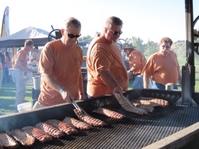
(Robert Whitley's Creators Syndicate Wine Talk column for this week)
Come Labor Day, legions of grillmeisters across the land will man their stations, cooking tools in hand, for the last big barbecue of summer. I have my own fork and tong at the ready.
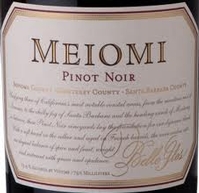 That's the easy part. Planning the big event, now that's another matter. I always like to have a little something for everyone: Marinated flat-iron steak, spicy wings, harpoon-caught swordfish, fresh salmon, homemade veal brats from my favorite butcher, farmer's market corn on the cob. That's the easy part. Planning the big event, now that's another matter. I always like to have a little something for everyone: Marinated flat-iron steak, spicy wings, harpoon-caught swordfish, fresh salmon, homemade veal brats from my favorite butcher, farmer's market corn on the cob.
Once I fire up the grill, the meat starts burning and the smoke begins to billow, I am in the zone. There is but one thing missing: my glass of wine, the first of many. I never grill without it. That fact alone dictates that I have the wines for the day set aside in advance, close at hand.
Everyone will have their own wine preferences for the Labor Day menu, but I am a creature of habit with a big-tent approach to barbecue wines. Fond as I am of dry rose, I always include a selection of rose and boldly pour the first glass of rose for myself. I have found that if someone doesn't take the lead on rose, it often just sits there while the crisp whites get drained.
Rose is actually perfect with barbecue, delivering lip-smacking fruitiness with savory nuances that go well with smoky fare from the grill. This year, I plan to serve the 2009 Robert Oatley Rose of Sangiovese from Australia ($15) and the Ventana 2008 Rosado ($18) from Monterey, a beautiful dry rose made from Grenache and Syrah.
Those are merely suggestions. There are plenty of wonderful rose options from all over the world, especially the south of France, Spain and California.
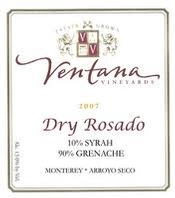 There's also a place at my Labor Day feast for simply refreshing, crisp white wines. This year, I plan to chill up several bottles of the Critics Challenge International Wine Competition Wine of the Year: the Chateau Ste. Michelle 2009 Dry Riesling ($15) from Washington's Columbia Valley. This inexpensive Riesling has mouthwatering acidity and makes a terrific quaffer. As a companion wine, and for a change of pace, the 2008 Tangent Albarino ($17) from California's Edna Valley is a delicious alternative. The Tangent Albarino won a platinum award at the 2010 San Diego International Wine Competition. There's also a place at my Labor Day feast for simply refreshing, crisp white wines. This year, I plan to chill up several bottles of the Critics Challenge International Wine Competition Wine of the Year: the Chateau Ste. Michelle 2009 Dry Riesling ($15) from Washington's Columbia Valley. This inexpensive Riesling has mouthwatering acidity and makes a terrific quaffer. As a companion wine, and for a change of pace, the 2008 Tangent Albarino ($17) from California's Edna Valley is a delicious alternative. The Tangent Albarino won a platinum award at the 2010 San Diego International Wine Competition.
For my salmon eaters, I will set out a slightly chilled Georges Duboeuf 2009 Flower Label Beaujolais-Villages ($11). The 2009 vintage in Burgundy's Beaujolais district was outstanding, and the wines are very well priced for the quality. The Belle Glos 2008 Meiomi Pinot Noir ($25) from Sonoma County, which I review in this week's Reviews pages, will have a place at the table, as well.
The meat eaters in my crowd will be treated to one of my favorite California Rhone-style blends, the 2008 Cotes-du-Robles ($21) from the Eberle Winery in Paso Robles. It has the guts and the complexity to tackle the steak and the brats, and the ripe, succulent fruit to handle the wings.
And for a slight uptick in seriousness, one of the most underrated and consistently delicious Bordeaux-style blends from the Napa Valley, the utterly sumptuous 2006 Franciscan Magnificat ($50).
Is it any wonder that I look forward to Labor Day each year?
Posted by Robert Whitley at 11:48 AM
|
|
August 25, 2010
(Robert Whitley's Creators Syndicate Wine Talk column)
Last week I recommended two wines that both thrilled me, and gave me pause. They are a Syrah and Merlot from Nickel & Nickel, the Napa Valley winery that is the epitome in impeccable winemaking.
Nickel & Nickel produces a number of vineyard-specific wines that illustrate the diversity and quality of terroir throughout Napa and Sonoma. The wines that got my attention were a Syrah from the Darien Vineyard in the Russian River Valley and a Merlot from the Suscol Ranch in the Jamieson Canyon district of the Napa Valley.
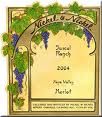 Merlot, as you may know, has been held in contempt ever since the movie "Sideways" cast a long shadow over the category with derisive comments from the star of the film. Syrah, rightly or wrongly, has never even had the cachet Merlot may have briefly enjoyed before it was so rudely dissed. Syrah has been touted as the next big thing in wine for nearly 20 years now, and we're still waiting. Merlot, as you may know, has been held in contempt ever since the movie "Sideways" cast a long shadow over the category with derisive comments from the star of the film. Syrah, rightly or wrongly, has never even had the cachet Merlot may have briefly enjoyed before it was so rudely dissed. Syrah has been touted as the next big thing in wine for nearly 20 years now, and we're still waiting.
I bring this up because neither grape gets the respect it deserves from the American wine enthusiast, despite the fact that Merlot-based wines from the Right Bank of Bordeaux and Syrah from the northern Rhone region of southern France are widely recognized as some of the finest in the world.
I believe I know why, and Nickel & Nickel provides the most important clue. The Darien Syrah and the Suscol Merlot are as good as red wine gets in California. They are world-class wines that can hold their own, regardless of price or region of origin. If everyone in California made Syrah and Merlot at this level, there would be no lack of respect to discuss.
But everyone doesn't.
Merlot suffered from its own popularity in the 1980s, when consumers fell in love with the wines of Duckhorn and Matanzas Creek. Vintners couldn't plant Merlot fast enough to catch the new wave of enthusiasm for varietal Merlot. Prior to Duckhorn, Matanzas and a few others, Merlot had been used primarily for blending.
"Most of the Napa Valley is too warm for Merlot," winemaker Cathy Corison told me recently.
Indeed, the best Merlot from Napa is grown in the cooler areas of the valley, such as Jamieson Canyon or Carneros. Too much Merlot ended up being planted in areas where it makes wine that isn't very structured or interesting.
 The same could be said of Syrah, although there is no doubt Syrah is more versatile than Merlot. Syrah suffers, I believe, from California's Baskin-Robbins approach to wine. Too many wineries believe they must produce a little bit of everything, and Syrah goes in whether it's suitable for the terroir or not. Then it's treated like a Cabernet Sauvignon and made in a ponderous style that is anything but inviting. The same could be said of Syrah, although there is no doubt Syrah is more versatile than Merlot. Syrah suffers, I believe, from California's Baskin-Robbins approach to wine. Too many wineries believe they must produce a little bit of everything, and Syrah goes in whether it's suitable for the terroir or not. Then it's treated like a Cabernet Sauvignon and made in a ponderous style that is anything but inviting.
The success of both grapes at Nickel & Nickel sends a message that should be loud and clear. When grown in the right place and handled intelligently and meticulously in the winery, California Syrah and Merlot can be as good as it gets.
To the California wine industry, I would simply say, more wines like this please!
Posted by Robert Whitley at 11:04 AM
|
|
August 21, 2010
Quick, name the five greatest California Syrahs you've ever tasted.
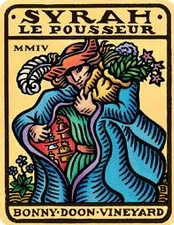 Uh, can't even think of one? Thought so. Therein lies the dilemma that confronts California winemakers who believe Syrah should be prominent in their portfolio, if only wine enthusiasts would buy it. I frequently hear the lament that Syrah doesn't sell. Uh, can't even think of one? Thought so. Therein lies the dilemma that confronts California winemakers who believe Syrah should be prominent in their portfolio, if only wine enthusiasts would buy it. I frequently hear the lament that Syrah doesn't sell.
I am sympathetic but far from surprised. Most California Syrah is boring. Unlike the scintillating Syrahs of the northern Rhone, and to some extent Australia and perhaps even Washington, California Syrah has but a handful of prominent benchmark wines.
Most good California producers who work with Syrah make a perfectly acceptable red wine. Seldom distinctive, seldom identifiable, certainly almost never wonderful or "great." California Syrah, IMHO, suffers from the Baskin-Robbins mentality of the California wine industry.
Wineries make Syrah whether their soils and climate are right for it -- or not. Same way they must make a Merlot, a Chardonnay, a Sauvignon Blanc, a Bordeaux blend, a Cabernet and whatever else comes to mind. Must keep those tasting-room folks busy, whether Syrah is in the winery's DNA -- or not.
The result is a blandness that is killing the American appetite for Syrah.
All of this came to mind this week when I tasted a truly outstanding California Syrah, the 2007 Nickel & Nickel from the Darien Vineyard in the Russian River Valley. My review of that wine in this week's issue of WRO was enthusiastic, and it made me wonder why there aren't more California Syrahs of this ilk.
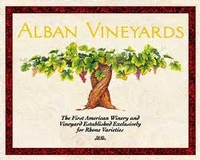 There are a few. Alban, located in the Edna Valley, makes a couple of vineyard-designated Syrahs that usually blow my socks off, though I haven't tasted the Alban wines in several years. Bonny Doon's Syrah is in this league and a steal at under $20. There are a few. Alban, located in the Edna Valley, makes a couple of vineyard-designated Syrahs that usually blow my socks off, though I haven't tasted the Alban wines in several years. Bonny Doon's Syrah is in this league and a steal at under $20.
Edmunds St. John, Qupe and Foxen also occasionally produce a mind-bending Syrah. But by and large, California Syrah has been a dud. California vintners either try to make it like a Cabernet and end up with a cloddish wine, or they blend it out, sometimes using it to plump up their Pinot Noir.
The only upside I see is that truly superb Syrah, such as the Nickel & Nickel Darien, stands out. But that also begs the question, if these handful of California producers can do Syrah so well, what's holding the others back?
Posted by Robert Whitley at 12:00 PM
|
|
August 20, 2010
Though the second annual Winemaker Challenge looms in the distant future -- it's just one week before the Super Bowl -- I have started the process of recruiting judges for this unique event.
Winemaker Challenge is a different breed of wine competition, for all of the judges are winemakers. One other wine competition I know of utilizes winemakers exclusively, but the format is different. The Winemaker Challenge deploys the winemakers in panels of three winemakers per to evaluate and award medals to deserving wines.
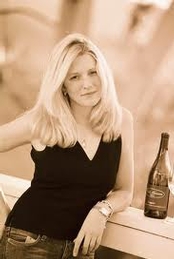 As I began to round up judges for the 2011 Winemaker Challenge, I knew I wanted many of the same judges from the inaugural Winemaker Challenge to return, but I also wanted to infuse new faces to keep the dialogue and interaction fresh. As I began to round up judges for the 2011 Winemaker Challenge, I knew I wanted many of the same judges from the inaugural Winemaker Challenge to return, but I also wanted to infuse new faces to keep the dialogue and interaction fresh.
So this year we've added the talented Mike Sullivan to the roster. Sullivan is a Pinot Noir specialist from the Russian River Valley, and winemaker and part owner of Benovia.
Also Stephanie Putnam of Raymond Vineyards. Raymond was recently purchased by Jean-Charles Boisset, whose mission is to convert the vineyards at the venerable Napa Valley winery to biodynamic and revolutionize how grapes are grown and wines are made in America's most renowned wine district. One of Boisset's first moves was to pirate Putnam away from the prestigous Far Niente winery.
We also got a commitment this week from Steve Edmunds of Edmunds St. John, a Rhone specialist. If boring Syrah is the rule in California, Edmunds St. John is the exception. Steve Edmunds is responsible for that and we're thrilled to have him on the 2011 team.
Morgan Clendenen is a refreshing new face as well. Owner and winemaker of Cold Heaven Cellars in Santa Barbara County, Clendenen ended up on my short list after a discussion we had about her winemaking philosophy. She prefers to make wines with structure, and she appreciates acidity, minerality and the need to respect wines that go with food. Someone has to stick up for wines made in that style, and Morgan will.
Then there is the estimable Roman Roth, the German-born winemaker at Long Island's Wolffer Estate. Roman has judged at the San Diego International Wine Competition for a number of years, but this will be his first go at Winemaker Challenge. Roth not only has a remarkable palate, he also has a pretty good handle on the winemaking challenges and triumphs of the eastern United States, particularly New York.
And, if we're lucky, the multi-talented Roth will yodel for us at the Saturday night judges' banquet!
PHOTO: One of the new faces, pictured above, is winemaker Morgan Clendenen of Cold Heaven Cellars.
Posted by Robert Whitley at 10:23 AM
|
|
August 18, 2010
(Robert Whitley's Creators Syndicate Wine Talk column this week)
ST. HELENA, Calif. — When a leading wine publication originally reviewed the 1996 Corison Kronos Cabernet Sauvignon, in 1999, the tasting note indicated it would be optimal to drink between 2001 and 2009. That would be a typical lifespan for many a good Napa Valley Cabernet, and the Kronos was undoubtedly a superb specimen of the genre through its wonder years.
It has now been 14 years since Cathy Corison put away the '96 vintage in the small French oak barrels she carefully chooses for complexity and nuance. She remembers the vintage fondly and well.
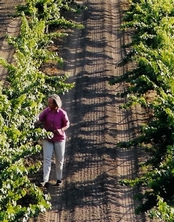 "It was a very long, cool growing season," she said as we chatted recently. "In fact, we didn't pick until November. I always thought it was a classic vintage. The '97 vintage was so ballyhooed that it kept the '96 in the shadows. "It was a very long, cool growing season," she said as we chatted recently. "In fact, we didn't pick until November. I always thought it was a classic vintage. The '97 vintage was so ballyhooed that it kept the '96 in the shadows.
"But it has aged very well. I always prefer the cooler vintages. I love the structure. They're fabulous with food."
As we sat and tasted the '96, I was reminded of that long-ago review. To my palate, the '96 Kronos is just now hitting its stride. The primary red and blue fruit flavors continue to shine as secondary aromas of leather, coffee and cedar emerge. This complexity of aroma is the best of times for an older Cabernet Sauvignon, and it comes as the slightly firmer tannins of the vintage have softened with age.
I do not share this with you on the expectation you will dash to the local wine merchant and pick up a bottle of the '96 Kronos, because that would be impossible. There were only about 400 cases made from this vintage, and most of that has either been consumed or carefully cellared.
My point is simply that Corison Cabernet Sauvignon is a special sort of wine. Cathy Corison, of course, is a special sort of winemaker, so it only stands to reason. She is focused and uncompromising in a world that's all too ready to catch the next wave.
We took a look at the 1997 Kronos, too, and Corison noted it was "a very ripe vintage." Indeed, the fruit was slightly more dense and darker, the body a bit heavier, but still with the tight structure and faint mineral note of a Corison Cab.
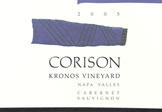 "Some say it was the first vintage to start this boozy, ripe style," she said. "It was big vintage. Almost double the normal crop. It's a very good wine. For me, it's missing some of the red and blue fruit brightness. Still, the wine is under 14 percent alcohol, and I've never de-alced a wine in my life." "Some say it was the first vintage to start this boozy, ripe style," she said. "It was big vintage. Almost double the normal crop. It's a very good wine. For me, it's missing some of the red and blue fruit brightness. Still, the wine is under 14 percent alcohol, and I've never de-alced a wine in my life."
Corsion never got the memo on the high-alcohol trend.
Or she ignored it. Her style has been consistent throughout her 30-plus years as a winemaker in the Napa Valley, which included stops at Chappellet and Staglin before she opened her own winery just south of St. Helena in 1987.
Her current location is a story in and of itself, because it reveals the nature of the Corison soul.
"My husband got the soil maps and we started looking for vineyards with Bale gravelly loam, somewhere between Ritherford and St. Helena," she said. "That's where you get the Rutherford dust, which is what made the Napa Valley. That's the sweet spot."
She enjoyed a good laugh on herself. "I wasn't asking for much, huh?"
"All of the spots we liked were up against the hills, where people build those trophy homes. That wasn't for us. Then my husband said, 'You know, that vineyard out on the highway has been for sale a long time."
The highway was Highway 29, the main traffic artery through the Napa Valley, and the vineyard was Kronos. There were few takers for Kronos at the price, and Corison believes potential buyers were frightened off because they mistakenly thought the vines were rooted on the dreaded AXR1 rootstock, which was susceptible to phylloxera and most likely would have to be replanted.
That turned out to be not true. The rootstock was the even more dreaded St. George, which had been largely abandoned by Napa Valley vintners because of its chronically low yields. Corison and her husband bid on the vineyard and got it. It was a marriage made in heaven. Corsion was more about quality than quantity, so the ton and a half to the acre suited her winemaking style nicely.
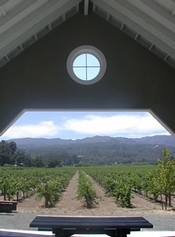 "With these vines, the yields are not only low, which is great for concentration of fruit and flavor, but the sugar accumulation (over the growing season) is slow," said Corison. "While everyone else is picking at 27 degrees of brix (a measurement of sugar level in winegrapes), I'm picking in November and struggling to get to 24." "With these vines, the yields are not only low, which is great for concentration of fruit and flavor, but the sugar accumulation (over the growing season) is slow," said Corison. "While everyone else is picking at 27 degrees of brix (a measurement of sugar level in winegrapes), I'm picking in November and struggling to get to 24."
What that means in lay terms is that Corsion gets her grapes ripe without the high sugar levels that elevate the percentage of alcohol in the finished wine. To those concerned about the soaring alcohol percentages found in many of today's table wines, Corsion Cabernet is a tribute to old-fashioned winemaking, a style geared for the cellar.
"All of these styles are just fashion," Corison said. "There were times when it was hard for me to stay the course. I make wines for me, not other people. I believe it's almost an ethical question. I have a moral obligation to make wines from this great vineyard that will develop in the bottle. That's my mission."
After tasting the splendidly evolved '96 Corison Kronos Cabernet, I would say mission accomplished.
Posted by Robert Whitley at 10:11 AM
|
|
August 11, 2010
From San Diego to San Francisco, California's coastal wine regions are in the midst of one of the coldest growing seasons on record.
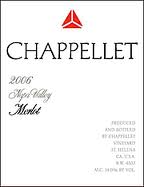 Over the weekend I spent a couple of days in Paso Robles while judging at the annual Winemakers' Cookoff. The daily high temps while I was there barely broke 70. Over the weekend I spent a couple of days in Paso Robles while judging at the annual Winemakers' Cookoff. The daily high temps while I was there barely broke 70.
"Typically Paso in August has daytime highs in the 90s and nightime lows in the 50s," said longtime Paso winemaker Gary Eberle. "We're getting the nightime 50s, but nowhere near the daytime 90s. We're two to three weeks behind a normal harvest schedule.
"I'm thinking about grafting everything over to Pinot!"
Of course, Paso Robles is Cabernet Sauvignon country and Cabernet needs heat to ripen. I found more of the same angst as I arrived in Napa, where daytime temps in August often top 100 degrees. That's a distant memory for panicked vintners, many who don't even have any color in their Cabs at this stage and are looking at a harvest sometime in November, when Pacific storms could become a factor.
"We need a nice, warm Indian summer," opined winemaker Cathy Corison of St. Helena's Corison Vineyards.
The danger for Napa is that king Cabernet won't ripen. That would open the door for Napa Merlot, which typically ripens two to three weeks earlier than Cab.
"I'd say Merlot outperforms Cabernet one in ten years," said Corison. "This could be the year."
 It may well be too early to make predictions along those lines, but I know one thing. On my way out to dinner tonight, I'm ditching the silk Tommy Bahama short-sleeve Hawaiian shirt and putting on a sweater. It may well be too early to make predictions along those lines, but I know one thing. On my way out to dinner tonight, I'm ditching the silk Tommy Bahama short-sleeve Hawaiian shirt and putting on a sweater.
It may not be winter, but it sure feels like winter!
By the way, Napa Merlots are generally a good buy. They are typically about half the price of Cabernet Sauvignon and a number of Napa producers make seriously good Merlot. A few of my favorites: Twomey, Nickel & Nickel, Chappellet, Truchard and Clos du Val.
Posted by Robert Whitley at 6:37 PM
|
|
August 3, 2010
I tasted many glorious wines a couple of weeks ago at the Riesling Rendezvous, an event aptly described by my Wine Review Online colleague W. Blake Gray as “the chummiest international wine gathering.” In addition to camaraderie and great wine there was lots of interesting and instructive stuff about Riesling. I’ve also been asked if there was one shining moment that stood out for me during the two-day get-together, and the answer is: Absolutely!
The incident that captured my imagination was unexpected, memorable and poignant. Its catalyst was a blind tasting of off-dry Rieslings, led by a panel that included some of the world’s most illustrious Riesling vintners, from Chateau Ste. Michelle, Helmut Dönnhoff, New Zealand’s Framingham Wines, Egon Müller, Weingut Robert Weil, and St. Urbans-Hof. There were 14 wines, each tasted blind, then discussed, and finally identified. Standouts among the unfailingly impressive wines were Chateau Ste. Michelle’s softly seductive 2008 Eroica, the beautiful and compelling Scharzhof Berger 2007 Kabinett, and Dr. Loosen’s gorgeous 2008 Urziger Wurzgarten.
About halfway through the tasting, one mysterious wine made attendees and panelists alike smack their lips and murmur that favorite word of wine professionals: “Yum!” Anthony Hedley, winemaker at Framingham, summed up what was clearly the general feeling in the room. “I’ve no idea where it comes from,” he said, “but this is the kind of Riesling that makes me want to either hurry back to my winery and start working harder, or give it all up to just go fishing and drink more of this wine.”
What was the wine that so impressed this urbane audience? Drum roll, please… It was Glenora Wine Cellars Riesling 2009, from New York’s 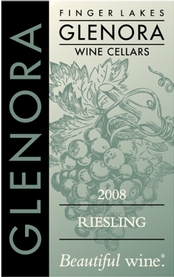 Finger Lakes region, which retails at the winery for about $18. Considering that few people knew much about the Finger Lakes, and fewer still had heard of Glenora, this was a shocker, especially given the other rarified and famous nectars in the same tasting. Later in the day, when I ran into Glenora’s winemaker Steve DeFrancesco, I congratulated him on the kudos his wine had garnered. Although he looked slightly dazed by it all, he wore an ear-to-ear grin. “I still can’t believe it,” he said. “And for this to happen while I was surrounded by all my gods--it’s just incredible!” Finger Lakes region, which retails at the winery for about $18. Considering that few people knew much about the Finger Lakes, and fewer still had heard of Glenora, this was a shocker, especially given the other rarified and famous nectars in the same tasting. Later in the day, when I ran into Glenora’s winemaker Steve DeFrancesco, I congratulated him on the kudos his wine had garnered. Although he looked slightly dazed by it all, he wore an ear-to-ear grin. “I still can’t believe it,” he said. “And for this to happen while I was surrounded by all my gods--it’s just incredible!”
Glenora was not the only Finger Lakes wine to draw praise at Riesling Rendezvous (also much admired were Anthony Road, Dr. Konstantin Frank, and Sheldrake Point). But Glenora does sum up the history of modern winemaking in the unique New York state region. One of the pioneers of contemporary Finger Lakes wines, Glenora was established in 1977. Its initial production of 5000 cases; a mere 3 decades later it turns out 45,000 cases. As innovative today as it was in the beginning, Glenora is the first winery in the United States to package some of its wines in the very new, very green Astra Pouch (basically an environmentally friendly bag-in-the-box minus the box).
Over the years Glenora has expanded from a small, basic cement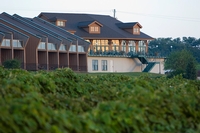 building to a handsome complex that includes winery and tasting room, an attractive 30-room inn, and a fine restaurant, all of it overlooking beautiful Lake Seneca. Since the Finger Lakes region is one of the most gorgeous viticultural regions I’ve ever seen, I highly recommend a visit there to all wine lovers. Autumn may well be the most beautiful and exciting time to visit. You’ll sip your way around the various wine trails, and nibble through the new Cheese Trail (there are 10 “cheeseries” spread throughout upstate New York). And you’ll definitely taste some of the best Rieslings on earth. building to a handsome complex that includes winery and tasting room, an attractive 30-room inn, and a fine restaurant, all of it overlooking beautiful Lake Seneca. Since the Finger Lakes region is one of the most gorgeous viticultural regions I’ve ever seen, I highly recommend a visit there to all wine lovers. Autumn may well be the most beautiful and exciting time to visit. You’ll sip your way around the various wine trails, and nibble through the new Cheese Trail (there are 10 “cheeseries” spread throughout upstate New York). And you’ll definitely taste some of the best Rieslings on earth.
Posted by Marguerite Thomas at 8:13 PM
|
|
August 1, 2010
Among the most impressive aspects of "Riesling Rendezvous" (the remarkable recent Riesling symposium recently co-hosted by Chateau Ste. Michelle and Dr. Loosen) was that the international dimension was not merely a matter of participation, but also performance.
Based on preconceptions, one might have imagined that the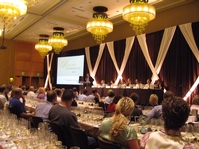 proceedings would be dominated in terms of excellence by the wines of Germany, Alsace and Austria, with Rieslings from elsewhere making more or less creditable showings and being patted patronizingly on the head by the European aristocracy. Or perhaps some New World Rieslings would show well enough, but only young wines that could rely on the grape’s inherent juiciness and precocious charm. proceedings would be dominated in terms of excellence by the wines of Germany, Alsace and Austria, with Rieslings from elsewhere making more or less creditable showings and being patted patronizingly on the head by the European aristocracy. Or perhaps some New World Rieslings would show well enough, but only young wines that could rely on the grape’s inherent juiciness and precocious charm.
But that is simply not what happened. New World wines showed very strongly, and several entrants from North America were particularly impressive. An especially notable case in point was observable in a tasting that showcased pairs of wines including producer’s current release alongside the same wine from a vintage that was 10 or more years old. One of the most striking wines in the lineup was the Cave Spring Dry Riesling from 2000, which remains remarkably fresh and energetic. It retains lovely floral aromas and primary fruit notes, but has also broadened in palate feel over the years, with a persistent finish that is focused by bright acidity and accented with wonderful notes of marmalade, minerals and spices.
Other stellar New World performers at Riesling Rendezvous include the following wines, each of which earned at least 90-point scores from me during blind tastings:
Jim Barry, Clare Valley (South Australia) Riesling “The Florita” 2005
Chehalem, Willamette Valley (Oregon) Dry Riesling Reserve 2008
Dr. Konstantin Frank, Finger Lakes (New York) Dry Riesling 2008
Efesté, Columbia Valley (Washington) Riesling “Evergreen” 2008
Eroica, Columbia Valley (Washington) Riesling 2008
Framingham, Marlborough (New Zealand) Riesling “Classic” 2009
Cave Spring, Beamsville Bench (Niagara Peninsula) Riesling CSV 2006
Posted by Michael Franz at 11:50 AM
|
|
 |
|